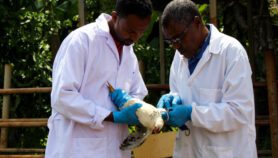Send to a friend
The details you provide on this page will not be used to send unsolicited email, and will not be sold to a 3rd party. See privacy policy.
It is widely recognised that knowledge is essential for development, and that developing countries have much to gain if they are to fully exploit the many opportunities opened up by new technologies. However, increasingly restrictive intellectual property rights are limiting the benefits that new technologies can bring to developing countries.
Digital technology and the Internet illustrate this trend. Although most developing countries lack the infrastructure and skills to take advantage of the opportunities created by information technologies, many are making efforts to bring telephone and Internet services to their cities and rural communities.
By improving access to information technologies, they hope to boost education, benefit from online services of different kinds, enhance the competitive capacity of local firms and generally increase their access to science and technology.
What many developing countries may find, however, is that investing in hardware and software is not necessarily sufficient to ensure the realisation of these goals. The knowledge they want to access is increasingly fenced off by a combination of old and new intellectual property rights, technological protection measures and limiting contractual conditions.
Digital technology, for example, permits the almost instantaneous and worldwide distribution of information through computer networks. But at the same time it has also increased the power of copyright owners to control copying, the sale of copies, and the public transmission of works such as articles and reports.
Furthermore, this technology has extended such control over reading and viewing protected material as well as on the use of copies. Technologies designed to prevent third parties from unauthorised access to and use of digital works can be used by right-holders to control, monitor and measure every application of the copyrighted work.
Moreover, the use of those technologies has been strengthened by prohibition of ‘anti-circumvention measures’, even when access to knowledge is sought for what traditional copyright law viewed as ‘fair uses’, such as education and research.
Most worryingly, perhaps, technological measures can erect barriers to accessing knowledge that is not subject to intellectual property protection, but lies in the public domain. For example, a regime introduced in Europe for protecting investment in the development of databases requires authorisation by or payment to the database owner for extracting information, whether such information is in the public domain or not.
Similar developments have taken place over the last two decades or so in other areas of intellectual property. For example, patent protection has been extended to living organisms and biological materials merely isolated from nature, such as genes. Furthermore, because of ambiguity in the criteria used for determining patentability, many minor (and in some cases trivial) developments have become subject to exclusive rights for periods of 20 years or more.
These trends, and the need to raise funds for research, have pushed universities and other public institutions into a situation in which the patent system is increasingly used to turn the results of their research into private property.
There are many reasons why policymakers, the scientific community and society at large should be concerned about these trends. The global scientific and technological enterprise, for example, may be gravely affected by increasingly privatised scientific results and technological outcomes, each controlled through strong ‘exclusionary’ rights.
The output of today’s research is, after all, an input into future research. The greater the rights (and hence the financial incentives to invest in knowledge production) exercised by one generation of knowledge producers, the greater the cost to the next-generation producers — and the lower their incentives to further develop that knowledge.
In this way, tighter intellectual property rights, and more stringent technological protection, may undermine the basic conditions for sustainable knowledge production. The recent drop in the productivity of pharmaceuticals research, for example, despite an enormous increase in the level of protection for its products, may be just one sign of crisis in a model that is excessively reliant on the protection of intellectual property rights.
Developing countries have particularly strong reasons to be concerned. First, the international rules on intellectual property rights are shaped by a small, narrow group of industry interests, whose members pay little or no attention to the likely implications of such rules for health, education and development in general.
Second, history shows how intellectual property regimes have evolved in developed countries in parallel with the processes through which such countries increased their technological capabilities. The United States, for example, denied copyright protection to foreign authors for almost the whole of the 19th century, while many European countries (as well as Japan) introduced pharmaceutical patents only when their industries had become relatively well developed.
Developing countries cannot, however, do the same under the current international regime, since they are being obliged to adopt an intellectual property regime that has already been set by others, and therefore find themselves at a significant disadvantage (see Graham Dutfield’s opinion piece ‘Are patent rules compatible with access to essential medicines?’)
Third, as indicated in a recent report by the World Bank, the new rules on intellectual property rights will require developing countries to make a massive transfer of resources to developed countries, as they will have to purchase licenses for the technologies they need.
In contrast, developing countries do not appear to be benefiting from the increased transfers of technology and foreign direct investment which, it was claimed, stronger intellectual property protection would promote.
Fourth, although the current international regime still allows developing countries to adopt various measures in the interests of increasing competition — such as compulsory licenses, parallel imports and exceptions to exclusive rights — a number of developed countries are trying to prevent the use of such measures, particularly where these are applied to provide access to patented medicines.
Concern over such issues is already reflected in international instruments such as the Declaration on the TRIPS (trade-related aspects of intellectual property rights) Agreement and Public Health, which was adopted in November 2001 by the World Trade Organization Ministerial Conference in Doha, Qatar, as well as the proposal for a ‘development agenda’ adopted by the Assemblies of the WIPO in September 2004. Such instruments are important steps towards recognising that although intellectual property rights can generate benefits, it can also create costs, particularly for developing countries.
To minimise such costs, the international community should work constructively towards addressing the problems created by over-protectionism in intellectual property rights. It is time to remember that the goal of intellectual property protection is not to enrich those best positioned to make use of the system at the global level, but to boost social and economic development by promoting both the creation and the dissemination and effective use of knowledge.Carlos Maria Correa, University of Buenos Aires, Argentina













